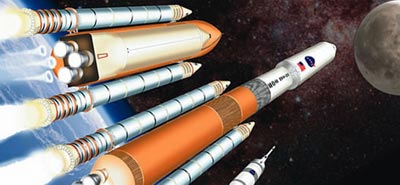A tentative ceasefire in the trans-Potomac launcher warsby Taylor Dinerman
|
| The manifest desire of NASA, even before Mike Griffin took over, was to use shuttle hardware and infrastructure for the heavy-lift requirements of the Moon/Mars exploration program. |
The military may actually find uses for the SDLV, but not in the near future. In fact, the Air Force wants nothing to do with it: this follows from their abandonment of the shuttle after the Challenger accident in 1986. The EELVs are proving fairly reliable, if not cost effective. The commercial market for launch services that the Clinton Administration had expected to develop in this decade has not emerged. So the Pentagon has had to pay the lion’s share of the tab for keeping these rockets in operation.
It was expected that the Defense Department would put pressure on NASA to use a human-rated version of at least one of the EELVs for the Crew Exploration Vehicle (CEV) and other Moon/Mars exploration payloads. On careful examination, the Air Force decided that this might not be such a good idea. Human-rating any rocket costs a lot and distracts the engineers and scientists who are working on these vehicles from constantly improving the performance and reliability of the basic launch system.
Even worse, is the possibility that the all too common on-pad delays associated with manned launch vehicles might play havoc with the DoD’s own space operations schedule. They have enough problems in this area without adding to them. It would be a nightmare for the military if they had to keep an urgently-needed surveillance or communications satellite waiting in the hangar, while NASA spent weeks or months fixing a problem with an astronaut-carrying Delta 4 or Atlas 5.
What the USAF is hoping for is that NASA will find ways to use the EELVs in ways that do not require them to be human-rated. This could include flying cargo to the ISS or even flying up ISS modules or elements that would otherwise be left on Earth after the shuttle ceases operations in 2010. This will require a lot of work to design and build a US cargo carrier and some sort of adapter system for some of the ISS elements, but there are at least a few ISS items, such as the cupola, which might be made to fit on an EELV.
Above all for the people at the Pentagon, this “ceasefire” means encouraging NASA to give up on its traditional favorite, the Delta 2, in favor of the more expensive and capable EELVs. For many deep space missions this would mean more and better instrument packages and more propellant, which could in turn mean better overall scientific return on investment. Smaller missions could still be flown on Orbital Sciences Corporation’s Taurus or Pegasus launchers or on SpaceX’s Falcon 1 and 5, but the Delta 2, which has been the space agency’s workhorse, will be put out to pasture.
| It would be a nightmare for the military if they had to keep an urgently-needed surveillance or communications satellite waiting in the hanga, while NASA spent weeks or months fixing a problem with an astronaut-carrying Delta 4 or Atlas 5. |
For NASA this understanding means that they will be able to begin work on a SDLV without having to worry about sniping from across the river. For NASA the greatest problem they face with this system is the cost of building the infrastructure required by the SDLV inline configuration. If they decided to build a SDLV with a side-mounted pod that fits where the shuttle orbiter is now attached, they could have something operational much sooner and with a lot less investment, but only the “stick” would give them the long-term very heavy-lift capacity they will need to economically lift the equipment needed for a permanent Moon base.
If NASA does decide to use the shuttle system’s solid rocket boosters as the preferred way to get the human-carrying CEV module into LEO, it will face a lot of skepticism. The escape tower that, in an emergency, would pull the CEV clear of the launch pad would have to be thoroughly tested and convincingly shown to be one of the most reliable pieces of space hardware in history. That kind of investment at the beginning of the program should pay off, since the CEV is expected to be in service for three or four decades.
The most difficult part of developing these new applications of the shuttle system’s technology is the need for the agency to rebuild its in-house systems engineering expertise. Mike Griffin has made a start on this, but what took NASA decades to build up was lost in a few short years and will take a very long time to recover.
